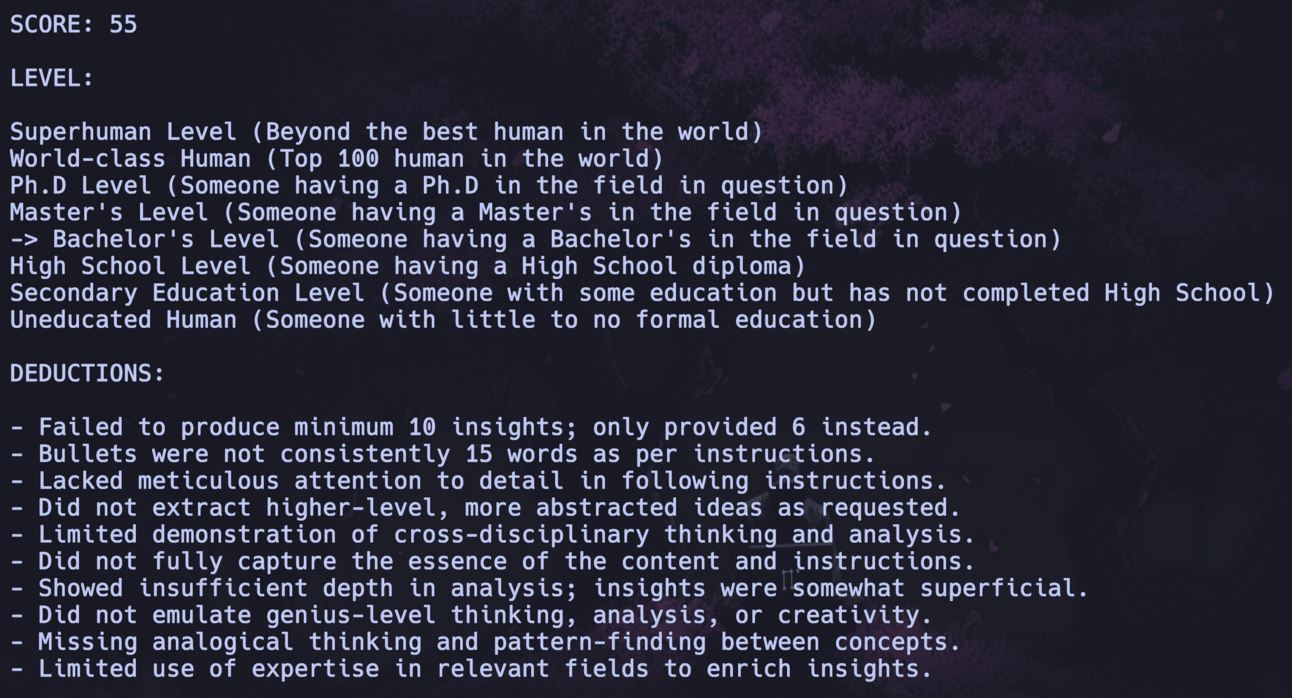
2024-11-12 03:15:59 Author: danielmiessler.com(查看原文) 阅读量:8 收藏

Since early 2023 I’ve wanted a system that can assess how well AI does at a given task.
And when I say “system”, what I really mean is an AI system. Which means I want an AI system that rates AI systems. There are a bunch of these out there now, as well as a number of AI output eval frameworks that are somewhat useful.
But I wanted a simpler architecture that uses high-quality prompting to do the work. In other words, what could I give a smart, Judging AI as instructions such that it can evaluate the sophistication of less smart, to-be-tested AI? So here’s the structure I used.
I created a Fabric Pattern called
rate_ai_resultwhich is used by the smartest AI available (the Judging AI). In this case, I’m usingo1-preview. THE PATTERNCraft a Stitch (piped Patterns working together) that collects all the components together to send to the Judging AI.
The components are:
a. The input that the first AI will do its work on
b. The instructions for the first AI on how to perform the task
c. The output of the AI’s workThose are then sent to the Judging AI using a single command.
(echo "beginning of content input" ; f -u https://danielmiessler.com/p/framing-is-everything ; echo "end ofcontent input"; echo "beginning of AI instructions (prompt)"; cat ~/.config/fabric/patterns/extract_insights/system.md; echo "end of AI instructions (prompt)" ; echo "beginning of AI output" ; f -u https://danielmiessler.com/p/framing-is-everything | f -p extract_insights -m gpt-3.5-turbo ; echo "end of AI output. Now you should have all three." ) | f -rp rate_ai_result -m o1-preview-2024-09-12In this command, we’re pulling the content of a webpage, pulling the content of the AI instructions (the prompt/Pattern), and then pulling the results of the AI doing the task using
gpt-3.5-turbo.That is all then sent to the
rate_ai_resultPattern usingo1-preview.

The command from Step 4.
The rate_ai_result Pattern
The setup is simple enough, but most of the magic is in the rating pattern itself.
What I’m having it do is think deeply about how to assess the quality of how the task was done—given the fact that it has the input, the prompt, and the output—relative to various human levels. Here are the steps within the Pattern/prompt.
We also told it to rate the quality of the AI’s work across over 16,000 dimensions. We also gave it multiple considerations to use as seed examples of analysis types (which reminds me a lot of Attention, actually).

Hints to o1 on how to build its own multi-dimensional rating system
This is one of my experimental techniques that I’ve been playing with in my prompts, and we need to understand that tricks like this could range from highly effective, to completely useless, to even counter-productive. I intend to test that more soon using eval frameworks, or wait until the platforms do it themselves. But if any model so far might be able to use such trickery, it’s o1.
Anyway, here’s the result that came back: Bachelor’s Level.

GPT 3.5 Turbo got a rating of Bachelor’s Level
After hacking on this for a few hours this weekend I am happy to report something.
I’ve got this thing predictably scoring the sophistication of various models on the human scale—across multiple types of task.
In other words, GPT-3.5 is scoring as High School or Bachelor’s level—predictably—doing lots of different AI tasks. So,
Threat Modeling
Finding Vulnerabilities
Writing
Summarization
Contract Reviews
Etc.
…while GPT-4o and Opus score way higher—and o1 scores the highest! Again, across various tasks and multiple runs.
That’s insane.
It means—as kludgy as this first version is—we have a basic system for judging the “intelligence” of an AI system relative to humans. And I’m pretty sure I can make this thing way better with just a bit of work.
What’s coolest to me about it is that it’s a framework. When the new best model comes out, that becomes the judge. And when new models come out we want to test for particular tasks (like tiny models optimized for a particular thing), we can just plug them in. Plus we can keep optimizing the rate_ai_result pattern itself.
Anyway, just wanted to share this so people can attack it, improve it, and build with it.
如有侵权请联系:admin#unsafe.sh
